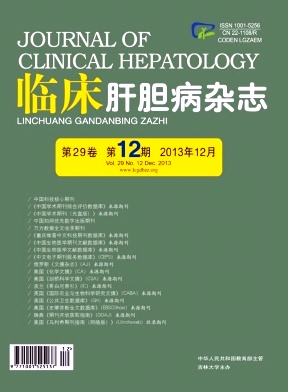|
[1]DAY CP.Non-alcoholic fatty liver disease:current concepts and management strategies[J].Clin Med, 2006, 6:19-25.
|
|
[2]CHALASANI N, YOUNOSSI Z, LAVINE JE, et al.The diagnosis and management of non-alcoholic fatty liver disease:practice guideline by the American Association for the Study of Liver Diseases, American College of Gastroenteroloy, and the American Gastroenterological Association[J].Hepatology, 2012, 55 (6) :2005-2023.
|
|
[3]MAEDA K, CAO H, KONO K, et al.Adipocyte/macrophage fatty acid binding proteins control integrated metabolic responses in obesity and diabetes[J].Cell Metab, 2005, 1 (2) :107-119.
|
|
[4] Fatty Liver and Alcoholic Liver Disease Study Group of the Chinese Liver Disease Association, Chinese Medical Association.Guidelines for prevention and treatment of nonalcoholic liver disease (revised version 2010) [J].J Clin Hepatol, 2010, 26 (2) :120-124. (in Chinese) 中华医学会肝病学分会脂肪肝和酒精性肝病学组.非酒精性肝病诊疗指南 (2010年修订版) [J].临床肝胆病杂志, 2010, 26 (2) :120-124.
|
|
[5]WEI C, YANG WM, YE ZQ.The expression and significance of FABP protein in bladder carcinoma tissue[J].J Clin Urol, 2008, 23 (1) :65-66. (in Chinese) 卫超, 杨为民, 叶章群.膀胱移行细胞癌脂肪细胞型脂肪酸结合蛋白的表达及其意义[J].临床泌尿外科杂志, 2008, 23 (1) :65-66.
|
|
[6]XU A, TSO AW, CHEUNG BM, et al.Circulating adipocyte fatty acid binding protein levels predict the development of the metabolic syndrome:a 5-year prospective study[J].Circulation, 2007, 115 (12) :1537-1543.
|
|
[7]KOH JH, SHIN YG, NAM SM, et al.Serum adipocyte fatty acid–binding protein levels are associated with nonalcoholic fatty liver disease in type 2 diabetic patients[J].Diabetes Care, 2009, 32 (1) :147-152.
|
|
[8]KIM YC, CHO YK, LEE WY, et al.Serum adipocyte-specific fatty acid-binding protein is associated with nonalcoholic fatty liver disease in apparently healthy subjects[J].J Nutr Biochem, 2011, 22 (3) :289-292.
|
|
[9]XU A, WANG Y, XU JY, et al.Adipocyte fatty acid binding protein is a plasma biomarker closely associated with obesity and metabolic syndrome[J].Clin Chem, 2006, 52 (3) :405-413.
|
|
[10]KOH JH, LEE MY, SHIN YG, et al.Serum adipocyte fatty acid–binding protein levels are associated with nonalcoholic fatty liver disease in type 2 diabetic patients[J].Diabetes Care, 2009, 32 (1) :147-152.
|
|
[11]LI XJ.The study prospect of insulin resistance and insulin resistance syndrome[J].Chin J Endocrinol Metab, 2000, 16 (5) :274-276. (in Chinese) 李秀钧.胰岛素抵抗及胰岛素抵抗综合征研究展望[J].中华内分泌代谢杂志, 2000, 16 (5) :274-276.
|
|
[12]WANG Z, XIA B, MA C, et al.Prevalence and risk factors of fatty liver disease in the Shuiguohu district of Wuhan city, central China[J].Postgrad Med J, 2007, 83 (977) :192-195.
|
|
[13]PARK JW, J EONG G, KIM SJ, et al.Predictors reflecting the pathological severity of nonalcoholic fatty liver disease:comprehensive study of clinical and immunohistochemical findings in younger Asian patients[J].J Gastroenterol Hepatol, 2007, 22 (4) :491-497.
|
|
[14]WU Z, XIE Y, MORRISON RF, et al.PPAR gamma induces the insulin-dependent glucose transporter GLUT4 in the absence of C/EBP alpha during the conversion of 3T3 fibroblasts into adipocytes[J].J Clin Invest, 1998, 101 (1) :22-32.
|
|
[15]RIBON V, JOHNSON JH, CAMP HS, et al.Thiazolidinediones and insulin resistance:peroxisome proliferator activated receptor gamma activation stimulates expression of the CAP gene[J].Proc Natl Acad Sci U S A, 1998, 95 (25) :14751-14756.
|
|
[16]MAKOWSKI L, BRITTINGHAM KC, REYNOLDS JM, et al.The fatty acid-binding protein, aP2, coordinates macrophage cholesterol traficking and infammatory activity.Macrophage expression of aP2impacts peroxisome proliferator-activated receptor gamma and IkappaB kinase activities[J].J Biol Chem, 2005, 280 (13) :12888-12895.
|
|
[17]FURUHASHI M, TUNCMAN G, GRGN CZ, et al.Treatment of diabetes and atherosclerosis by inhibiting fatty acid binding protein, aP2[J].Nature, 2007, 447 (7147) :959-965.
|
|
[18]HUI X, LI H, ZHOU Z, et al.Adipocyte fatty acid-binding protein modulates inflammatory responses in macrophages through a positive feedback loop involving c-Jun NH2-terminal kinases and activator protein-1[J].J Biol Chem, 2010, 285 (14) :10273-10280.
|
|
[19]CAO H, MAEDA K, GORGUN CZ, et al.Regulation of metabolic responses by adipocyte/macrophage fatty acid–binding proteins in leptin-deficient mice[J].Diabetes, 2006, 55 (7) :1915-1922.
|
|
[20]TUNCMAN G, ERBAY E, HOM X, et al.A genetic variant at the fatty acid-binding protein aP2 locus reduces the risk for hypertriglyceridemia, type 2 diabetes, and cardiovascular disease[J].Proc Natl Acad Sci U S A, 2006, 103 (18) :6970-6975.
|
|
[21]HUANG L, ZHOU DJ.The association of serum adipocyte fatty acid binding protein with adolescent obesity[D].Second Military Medical University, 2009. (in Chinese) 黄岚, 邹大进.血清脂肪细胞脂肪酸结合蛋白与青少年肥胖症的相关性研究[D].第二军医大学, 2009.
|














 DownLoad:
DownLoad: